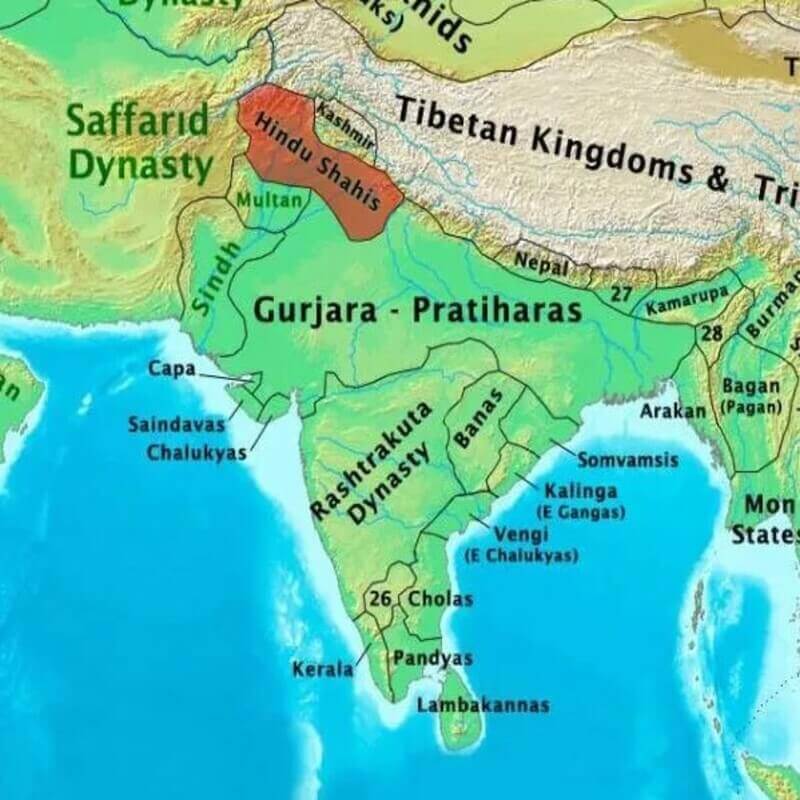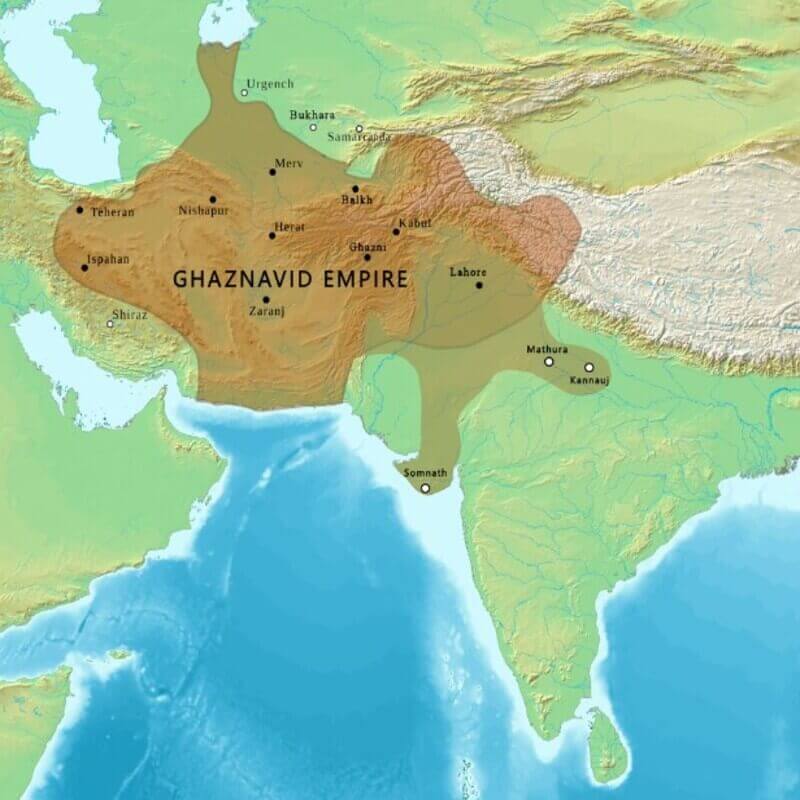
The arrival of Islam in India is dated to medieval times after the decline of Rajput kingdoms in the north. Read here to know about the conquests that brought Muslim rule to India.
During the early 7th Century, there were two major powers outside India and China:
- The Sassanid Empire was a Zoroastrian nationalistic dynasty that ruled Persia (modern-day Iran).
- Eastern Roman Empire/Byzantine Empire which was an orthodox Christian empire (The catholic Western Roman Empire had already fallen around 480 CE).
Between 602 and 628 CE, these empires were constantly waging war against each other, and the region around modern-day Iran, Jordan, and Syria was always war-torn.
- These regions including the Arab peninsula occupied numerous polytheist tribes.
- The Arab tribes were caravan traders who sold luxury goods to Constantinople and Persia. The caravan trade routes made Mecca and Medina rich cities.
The long war between these powers came to end with the Byzantines defeating the Persian Sassanid Empire.
- But the dissolution of the Sassanid Empire and the eventual decline of Byzantines created a political and religious power vacuum in the Middle East region.
- The long wars between Rome and Persia caused an economic decline in the region. The customers for Arab luxury products decreased in times of war.
- There was no pilgrimage to the polytheist sites during the war which dried up the coffers of Mecca and Medina.
- Since the monotheist Romans had won, their monotheistic ideas and tales of Jesus and Moses were fast spreading in the Middle East.
During this time, Muhammad (who later became Prophet Muhammad) was born to the powerful Quraysh tribe of Mecca. It is said that he had visions of god and angel Jibril which led him to preach a new religion following only one god, Allah.
The new religion, Islam, slowly brought all the different tribes of Arabia under one roof and united them.
Prophet Muhammad is believed to belong to the time period between 570 and 632 CE. According to the Hijri calendar, the migration of the Prophet and his followers from Mecca to Medina took place in 622 CE.
- After the death of the Prophet, the religious and political heads of Islam (Ummah) were called Caliphs.
The important Islamic Caliphates:
- Rashidun Caliphate (632-661) believed to be the four rightly guided caliphs
- Ummayyad Caliphate (661-750) ruled from Damascus
- Abbasid caliphate (750-1251) ruled from Baghdad. The caliphate is briefly transferred to the Mamluk Turks of Egypt after this.
- Ottoman Caliphate (1517-1924) ruled from Istanbul, which disintegrated after World War I.
The conquests to spread Islam reached the doors of the Indian sub-continent during the rule of the Ummayad Caliphate.
The Islamic Conquest of Sind (712 CE)

The Umayyad Caliphate sent his 18-year-old nephew, Muhammad Bin Qasim to attack the areas beyond Baluchistan.
He attacked and defeated the Chachaa ruler of Sindh, Dahir, and established Arab rule over Sindh, from where later conquests erupted.
The age of conflict (1000-1200 CE):
By the end of the 9th century, the Abbasid Caliphate started declining and the farther regions of the kingdom start to become independent.
The age is known as the end of the Arab culture of learning and science. The Arabs were replaced by Turks from Central Asia (Turkestan) ruling over many Islamized states.
- The Turks had entered the Abbasid Empire, during the century as palace guards and mercenary soldiers. But they soon became powerful kingmakers.
- The provincial governors became powerful and Caliph just performed the formality of bestowing the Amir-ul-Umra (Commander of Commanders) on the generals.
- These new rulers assumed the title of ‘Amir’ at first but became ‘Sultans’ later.
The Turkish tribesmen brought with them their habit of looting and plunder, as was prevalent in Central Asia (Like in the ancient era, India faced invasions from the Kushans, and Sakas, Huns, from Central Asia). They believed in pagan gods.
- Their mode of warfare was rapid raids and retreat which was possible because of their excellent quality of horses and habit of covering large distances on horseback.
- Numerous kingdoms rose and fell in rapid succession, as the invading Turks were quick to switch loyalties.
But over the years, in between enumerable wars, the Turks were slowly converted to Islam and a new class of soldiers was developed amongst them called the Ghazi, who was fierce soldiers and religious missionaries as well.
The Turko-Islam Ghaznavid Kingdom

Turkish slave Alaptigin, a Samanid governor, established an independent kingdom at Ghazni, Afghanistan (962 CE).
The Samanid kingdom soon ended and the Ghaznavids took up the task of ‘defense of Islam’.
His son, Sabuktigin (977-998 CE) became completely independent in 988 CE. He was later known as Mahmud of Ghazni. He defended the Afghanistan region from the Turkish tribal invaders of Central Asia.
- The Persians even though adopted Islam, never accepted Arabic culture.
- The history and conquests of Persian kingdoms and Ghaznavids were glorified by Persian poet Firdausi who was Mahmud’s court poet,
- He wrote Shah Namah where he portrayed Mahmud as a rightful Persian ruler even though he was a Turk.
The arrival of Islam in India
Mahmud attacked India 17 times over his period of reign. He initially attacked the Hindushahi rulers of Peshawar and Punjab and even the Muslim rulers of Multan (established by Muhamad bin Qasim).
Battle of Waihind (1008-09): This was fought near Peshawar between Mahmud and Hindushahi ruler Anandapala who was in alliance with the ruler of Multan and the Khokars tribe of Punjab.
- The battle was won by Mahmud as he captured both their territories.
Mahmud’s most dreadful attacks on India were:
- Raid of Kanauj and Mathura in 1018 where after plundering them, he returned via Kalinjar, Bundelkhand, with huge riches.
- Raid of Somnath Temple in 1025.
However, Mahmud did not annex these states but marched from Multan to Somnath, through Rajputana, without encountering any resistance.
Mahmud died in 1030 and was succeeded by his son Masud. But Masud could not maintain the kingdom and was defeated by the Seljuk Turks.
Ghaznavids lost most of their territories and ruled only in Punjab and Ghazni. But they continued their raids of India.
A Persian scholar, Al-Biruni came to India with the Ghaznavids and wrote the book Kitab-ul-Hind or Tahqiq-i-hind, describing the society, culture, and kingdoms of medieval India.
- In his account, he highlights choice parts of the Gita, the Upanishads, Patanjali, Puranas, the four Vedas, scientific texts (by Nagarjuna, Aryabhata), and stories from Indian mythology.
- He also compared Indian thought to the Greek thought of Socrates, Pythagoras, Plato, Aristotle, Galen, and others, and at times with Sufi teaching.
The Ghaznavid conquests opened the route for the spread of Islam in India as the north-western frontier was breached. The in-fighting between the Rajput Kingdoms gave the Ghaznavids a clear pathway to attack and raid western India numerous times. After the death of Ghazni, many more Islamic conquests comes India’s way, eventually setting up sultanates here.
–Article written by Swathi Satish





Leave a Reply